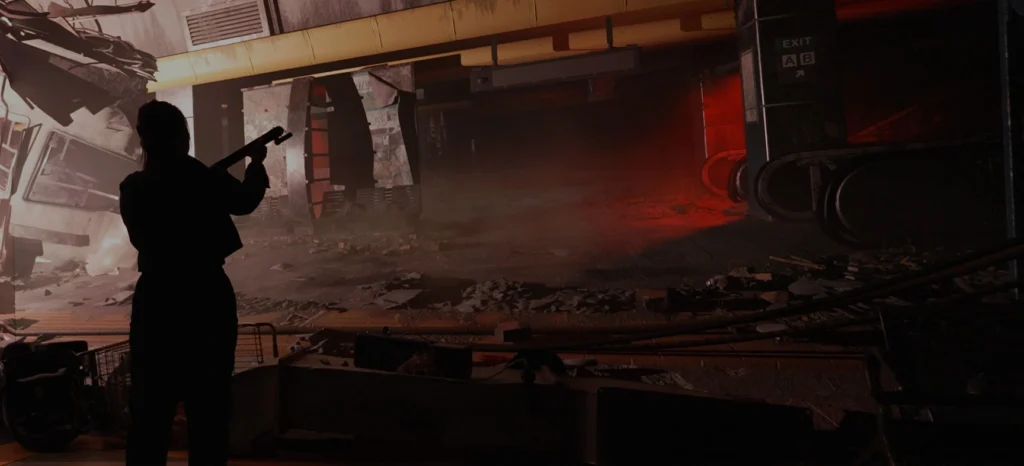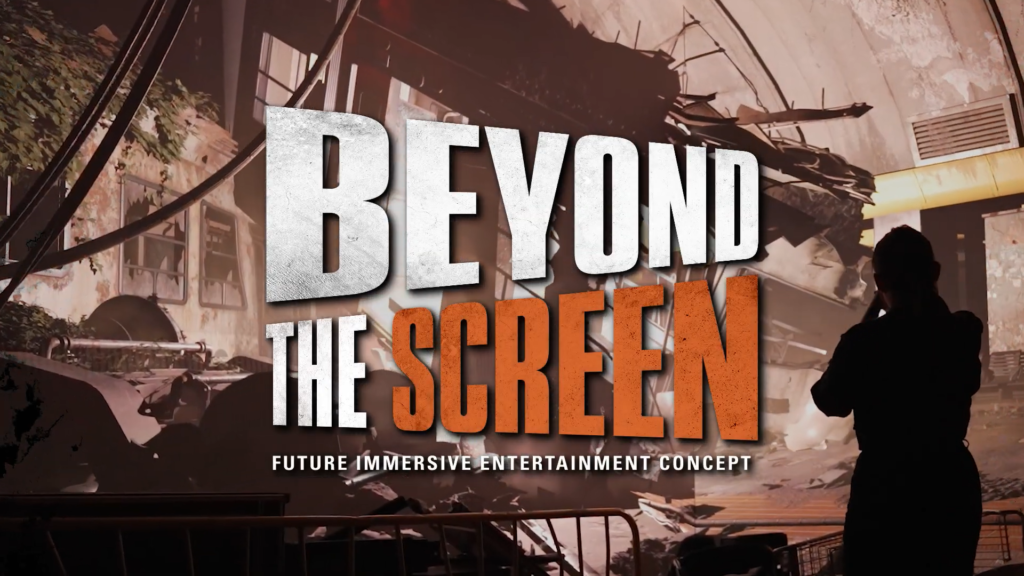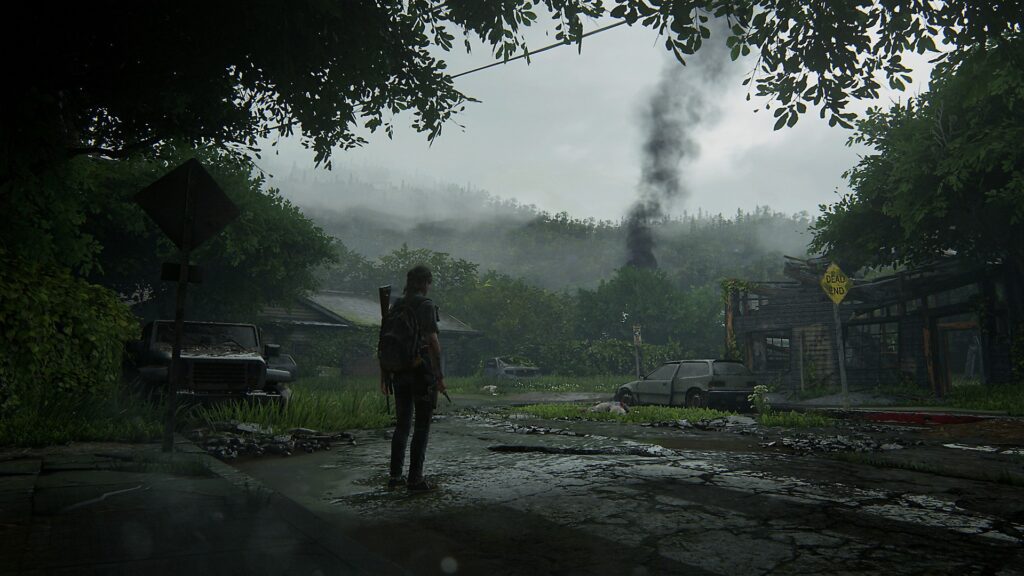
Sony’s Immersive The Last of Us Experience
In January 2025, during the CES event in Las Vegas, Sony broke through traditional entertainment barriers with an immersive demonstration based on the universe of the acclaimed video game The Last of Us. This experience wasn’t a simple VR adaptation or theme park ride: it was a physical interactive installation that combined the best of cinematic production design, advanced sensory technology, and playable storytelling. It was a clear example of where digital entertainment is headed, where video games are no longer just something you watch or play from a controller and a screen, but physical experiences you can fully step into.
The installation allowed participants to literally step into a quarantine zone inspired by the game’s dark, damp, and tense settings. The environment was built in a physical space with the look and feel of underground tunnels from a collapsed post-apocalyptic city. Nothing was improvised. The set design was on par with big-budget film productions. The level of detail included debris, unsettling ambient sounds, lighting that shifted based on the player’s actions, and smoke and vibration effects that intensified the constant feeling of danger.
Modular Crystal LED and Surround Sound
One of the most standout features of this experience was the use of modular Crystal LED panels, developed by Sony. These panels, offering a much higher pixel density than conventional screens, were used to visually extend the real scenario, simulating depth and dynamism with a fidelity that was nearly indistinguishable from reality. Unlike simple projections, these panels were structurally integrated into the physical environment, completely blurring the lines between digital and tangible.
In addition to the visual component, the path included interactive elements that required the player to move, react, and make decisions as if they were actually inside the game. Motion sensors were used on flashlights and simulated weapons, allowing players to aim, scout routes, or light up paths intuitively. Simulated gunfire against enemies was brought to life using animatronics synchronized with surround sound effects. The experience was designed to activate the physical senses: floors vibrated when a creature approached, the air changed temperature when moving through different sections, and the 3D sound intensified every step, every breath, every moment of tension.

While some sensory elements like scent or direct physical impact weren’t yet implemented in their final version, Sony made it clear this demonstration was only an early step. The company isn’t just experimenting with new forms of interactive entertainment, but also aiming to develop a platform that serves as a foundation for narrative, educational, and corporate experiences. The goal is to create environments where learning, gameplay, and emotion can coexist without barriers between user and setting.
Beyond the Screen: Sony’s Program to Take Immersive Experiences to the Next Level
This initiative is part of Sony’s program called “Beyond the Screen,” through which they aim to expand audiovisual experiences beyond cinema or traditional video games. It’s not about replacing conventional gaming, but about complementing it with new formats. The case of The Last of Us was strategically chosen: it’s a franchise known not only for its intense storytelling but also for its success in both television and gaming. Leveraging such an emotionally charged world made it the perfect showcase for the potential of technology applied to real-life immersive experiences.

The experience presented at CES hasn’t been commercialized, at least not yet, but Sony hinted they’re exploring its viability as an entertainment format in specialized centers. It’s not out of the question that, in the short or medium term, similar experiences could appear in major cities, integrated into theme parks, tech expos, or even as part of promotional campaigns for games and series. The company believes that this kind of setup could become a new form of entertainment, on par with immersive theater, escape rooms, or audiovisual concerts.
In terms of reception, CES attendees highlighted the fluidity of the experience, the intense atmosphere, and the way it managed to sustain suspense from beginning to end. Unlike many VR proposals that depend on headsets or the user’s imagination to complete the immersion, here everything was physically present. There was no need to suspend disbelief: the environment was real, tangible, and sensory. That difference marked a turning point in how the relationship between player and game is conceived.

The Technology That Could Redefine the Very Concept of Video Games
What Sony demonstrated with this project isn’t just a technical evolution, but a paradigm shift. People are starting to talk about “live-in experiences” instead of video games, where the line between actor and audience completely disappears. In this model, the user doesn’t play as a character: the user becomes the character. If this kind of technology is implemented on a large scale, it could open an entirely new market for development studios, visual artists, sound designers, and sensory engineers.
Total immersion is no longer a futuristic promise: it’s a tangible reality. And while today it still belongs to the experimental space, it’s clear that Sony has taken the first step toward an era in which gaming won’t be something you do sitting down, but something you live standing up, with all your senses engaged, inside the game itself, just like those sci-fi movies from past decades where people are seen gaming in virtual reality; well… we’re a step away from living that once-dystopian future.

And now that our brains are so used to processing headlines about Musk and his robots we had only seen in movies before, or anything related to AR (augmented reality), or even the same AI we consume and use every single day, maybe this Sony project is simply the next logical step in that evolution (?) …Sure, placed in that context of global tech advancements, maybe it doesn’t sound sooo fantastic, but now think about it with your gamer mind: do you realize we’re one step away from living Sword Art Online?… Come on, be nice and drop by the comments to let us know your thoughts, will you? You know gamer, we’ll be reading you! 😉
Images Source: Sony Beyond The Screen Project, Sony Official YouTube Channel, Reddit





